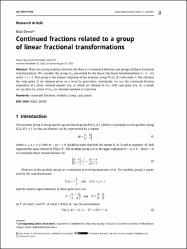| dc.contributor.author | Demir, Bilal | |
| dc.date.accessioned | 2024-06-06T07:38:17Z | |
| dc.date.available | 2024-06-06T07:38:17Z | |
| dc.date.issued | 2023 | en_US |
| dc.identifier.issn | 2391-5455 | |
| dc.identifier.uri | https://doi.org/10.1515/math-2023-0117 | |
| dc.identifier.uri | https://hdl.handle.net/20.500.12462/14814 | |
| dc.description.abstract | There are strong relations between the theory of continued fractions and groups of linear fractional transformations. We consider the group G 3,3 generated by the linear fractional transformations a=1-1/z and b = z + 2 b=z+2. This group is the unique subgroup of the modular group PSL (2, Z)) with index 2. We calculate the cusp point of an element given as a word in generators. Conversely, we use the continued fraction expansion of a given rational number p/q, to obtain an element in G 3, 3 with cusp point p/q. As a result, we say that the action of G 3, 3 on rational numbers is transitive. | en_US |
| dc.language.iso | eng | en_US |
| dc.publisher | Walter De Gruyter GMBH | en_US |
| dc.relation.isversionof | 10.1515/math-2023-0117 | en_US |
| dc.rights | info:eu-repo/semantics/openAccess | en_US |
| dc.rights.uri | http://creativecommons.org/licenses/by/3.0/us/ | * |
| dc.subject | Continued Fractions | en_US |
| dc.subject | Cusp Points | en_US |
| dc.subject | Modular Group | en_US |
| dc.title | Continued fractions related to a group of linear fractional transformations | en_US |
| dc.type | article | en_US |
| dc.relation.journal | Open Mathematics | en_US |
| dc.contributor.department | Necatibey Eğitim Fakültesi | en_US |
| dc.contributor.authorID | 0000-0002-6638-6909 | en_US |
| dc.identifier.volume | 21 | en_US |
| dc.identifier.issue | 1 | en_US |
| dc.identifier.startpage | 1 | en_US |
| dc.identifier.endpage | 8 | en_US |
| dc.relation.publicationcategory | Makale - Uluslararası Hakemli Dergi - Kurum Öğretim Elemanı | en_US |




















